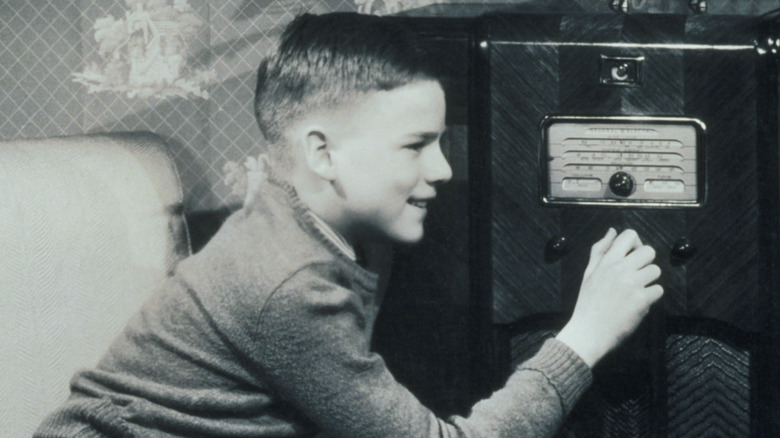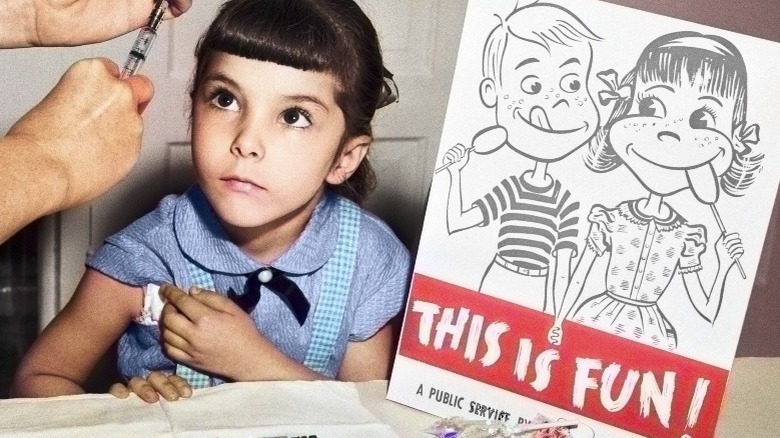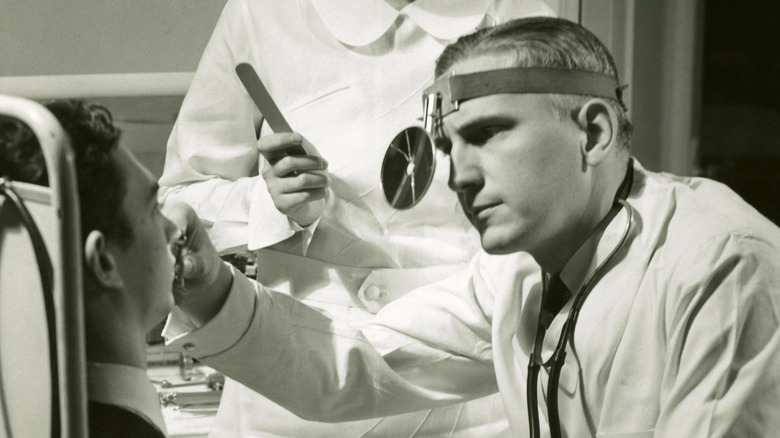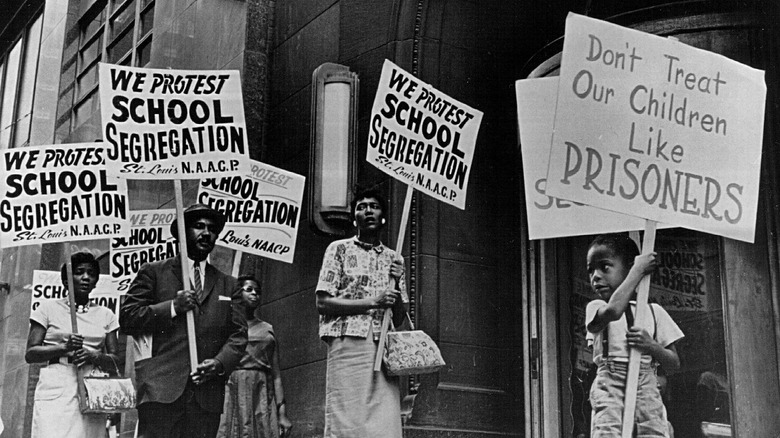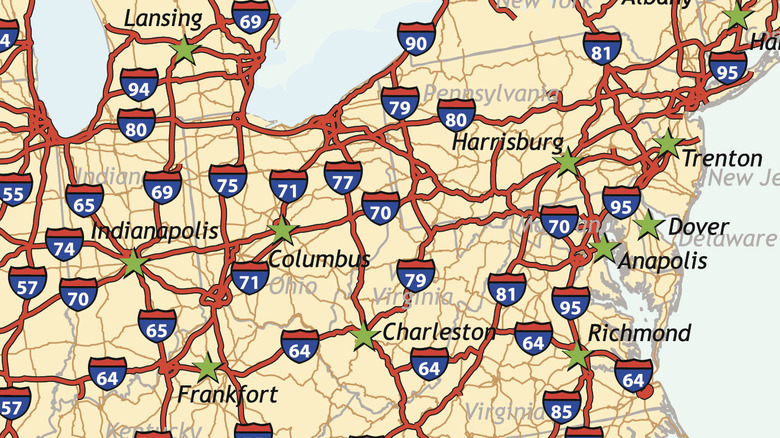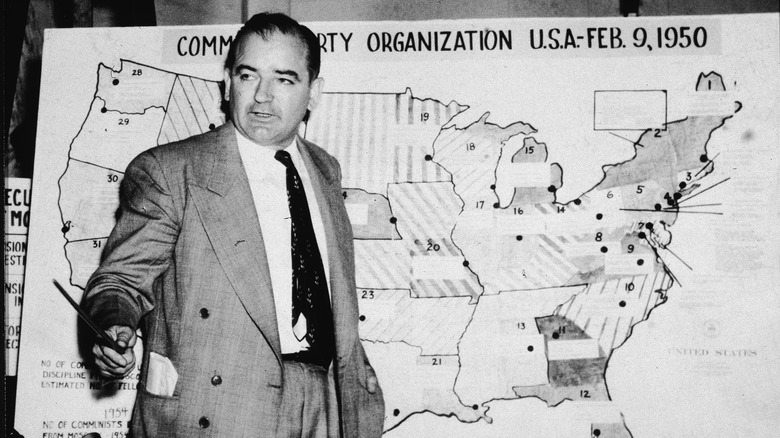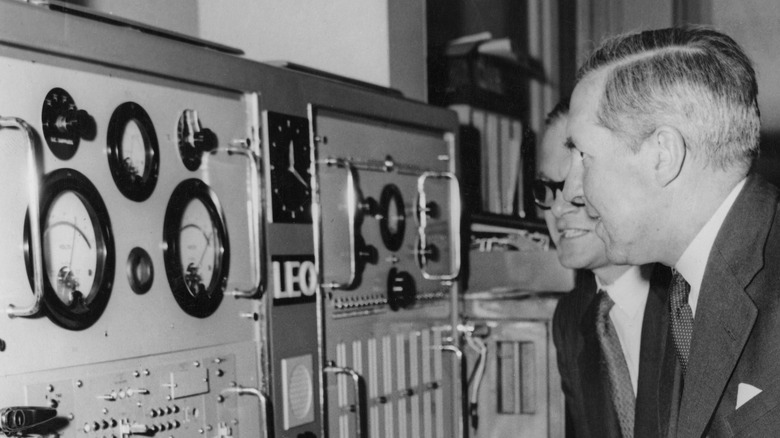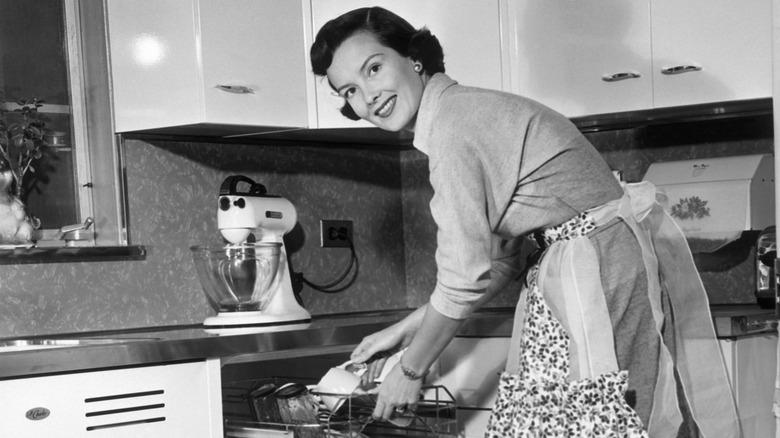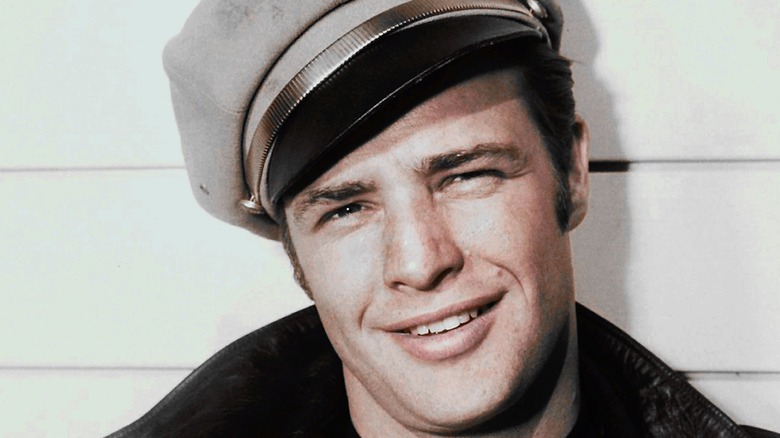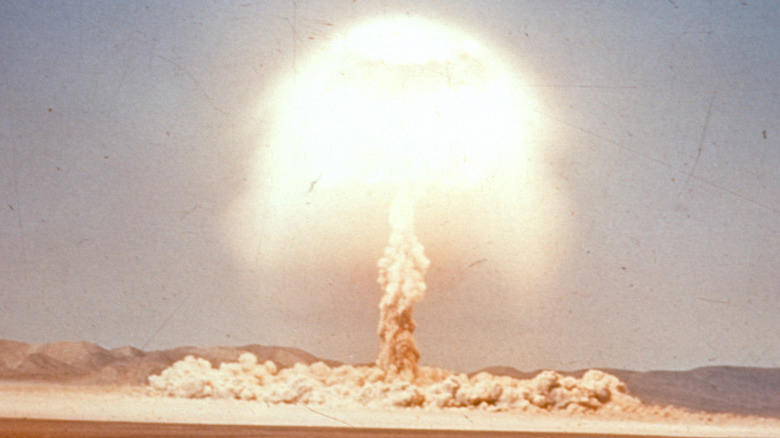Life In The 1950s: An American Dream Or A Nightmare?
It was the best of times. It was the worst of times. Perhaps it was both ... or maybe neither. Frankly, how one perceived the 1950s in the United States likely depended on who one asked. For many, it was a time of economic prosperity and growth, of home ownership, and fancy new appliances and white picket fences. For others, it was a decade of struggles: racism, sexism, frightening diseases, and fears for the future. Beneath the veneer of a prosperous and peaceful America was another nation where poverty and oppression continued to exist.
Needless to say, these postwar years saw America grow and change significantly. It was also a time in which the U.S. following the Allied victory in World War II, was trying to find its place on the world stage, struggling with the demons of its past as society progressed forward. "Whatever America hopes to bring to pass in the world," President Dwight D. Eisenhower declared in his 1953 inauguration speech (per UC Santa Barbara), "must first come to pass in the heart of America."
The economy grew rapidly
As is often the common modern perception of the 1950s, attaining the middle-class life wasn't simply a fantasy from "Leave it to Beaver." The economy really was booming in the U.S. throughout the decade. In the decade and a half following World War II, the U.S. gross national product increased by 150%, partially due to government investments in public goods such as schools, roads, and military spending. This all helped boost the country's overall economic output, which, in turn, created more decent-paying jobs that helped build the middle class. These gains also came from the organizing of labor unions. During the 1950s, union membership peaked at 35% of the total workforce, according to a report by the Bureau of Labor Statistics (via the Congressional Research Service).
The economic boom was also fueled by a postwar embrace of consumerism. In previous decades, excessive spending was sometimes viewed as a form of society's slide into decadence and decay, but now it was viewed as an act of economic patriotism. A family spending income on not only home ownership but also on cars, radios, televisions, and luxurious appliances was now understood to be an essential part of attaining middle-class status. The expansion of these industries also contributed to the economic boom. For instance, by 1954, General Motors was able to celebrate the completion of its 50 millionth vehicle produced in its factories.
Polio was a legitimate fear
One of the most widespread fears for parents in the early 1950s was that their child or children would contract poliomyelitis. Polio certainly was not a new disease, but beginning in the late-1940s and into the following decade, the outbreaks were increasing in size and scope. Centers for Disease Control and Prevention data shows that the poliovirus was responsible for as many as 35,000 people becoming disabled in the U.S. each year, the majority of which were young children. This was a time in which a vaccine, while in development, was not yet available and, as a result, throughout the early-1950s, many parents feared allowing their children to attend crowded events.
For many who were exposed, symptoms for those infected by the poliomyelitis virus often were simply similar to influenza, but for a small yet still significant percentage, the virus would attack the spine or even the brain, as per the CDC. In 1% of those infected, the virus would enter the nervous system, which could lead to paralysis or, if it attacked the muscles one uses to breathe, even death, as per Yale School of Medicine. Fortunately, a vaccine developed by Dr. Jonas Salk was made publicly available by 1955, which helped eradicate the disease throughout America and elsewhere. In an issue of LIFE Magazine, Salk was described as a "national hero," especially as he was committed to not accepting any money for the vaccine's creation.
There were numerous major medical advances
The polio vaccine was not the only major medical advancement of the 1950s. It was a decade of numerous and extremely important advances in the field, many times being referred to as a "Golden Age" of medical advancement – kidney dialysis, innovations to extend the life of the human heart, and new cancer treatments among them. The National Cancer Institute notes that before the 1950s, a cancer diagnosis almost certainly meant surgery or radiation. Fortunately, the decade ushered in a variety of new drug treatments to provide other options for treatment and increase the length and likelihood of survival.
In 1950, a new and effective antibiotic called terramycin was also released, cutting down on deaths from infections. A few years later in 1954, the first successful open-heart surgery using cross-circulation was conducted on a 3-year-old child. It was a pioneering procedure, effectively providing direct access and visualization of the heart, and was also the first successful repair of a common congenital heart defect.
Oral contraceptives also became available during the decade, giving women more agency and flexibility when it came to starting families. This was the decade in which the federal government established the U.S. Department of Health, Education, and Welfare as well, which assisted with public health at a national level. Overall, the 1950s was a decade in which medical advances would assure that people could live longer and healthier lives than in previous decades.
Racism was still rampant
From a legal standpoint, the 1950s did see some progress in combating racism at the federal level. The Civil Rights Act of 1957, for instance, was passed into law. This was the first major civil rights legislation passed into law since the years following the Civil War. The Supreme Court also ruled that schools could no longer be segregated. Still, despite this progress, many Jim Crow-era laws remained on the books throughout the U.S., and racism on an individual and systemic level was still a significant problem. For example, although Brown v. Board of Education ruled that schools couldn't be segregated, many states and schools resisted. Perhaps the most famous example of this resistance was the Little Rock Nine, a term used to describe the nine Black teenagers who became the first to integrate Central High School in Little Rock, Arkansas, in 1957. These students faced fierce resistance from white community members, teachers, and students as they attempted to integrate, ultimately resulting in the president calling in the National Guard and U.S. Army soldiers to the school campus.
In many cities, racial tension led to attacks and race riots, such as in Chicago in 1951. In some states, marrying someone of a different color could lead to one's arrest, such as with Mildred and Richard Loving in Virginia in the late-'50s. The kidnapping and murder of 14-year-old Emmett Till in 1955 further demonstrated this racism as not only systematic but violent. However, the lack of justice helped motivate young Black Americans to join the Civil Rights Movement.
The interstate system was approved
While some may take it for granted today, the approval of the Federal Aid Highway Act in 1956 changed transportation as we know it in the U.S. The concept was to create a coast-to-coast superhighway, and it gained the support of President Dwight D. Eisenhower, who realized that having an interconnected highway system would benefit the country's national defense, as demonstrated in Europe during World War II. With its bipartisan passage, billions of dollars were to be spent on 41,000 miles of interstate highways. Secretary of Commerce Sinclair Weeks referred to the plan as "the greatest public works program in the history of the world" (per Federal Highway Administration).
While this did make transportation faster and easier across America, the story wasn't all positive. Many people were forced out of their homes by the construction, and there seemingly was little regard for the communities that were being carved down the middle and split apart by the creation of these highways. Many home and business owners were negatively affected by the interstates cutting through neighborhoods, and they pushed back (with little success) — especially Black and Hispanic neighborhoods, which were disproportionately the target of the worst displacement and separation.
The Red Scare polarized Americans
In the years following World War II and with the increase in world influence and power by the Soviet Union, many had fears of communism spreading throughout the U.S. These fears culminated in a witch hunt for communists led by U.S. Sen. Joseph McCarthy between 1950 and 1954. McCarthy alleged that there were communists who had infiltrated every facet of the United States government, including the military. He wielded his power as a committee chairman to investigate and interrogate people on their alleged ties to communists. Many lived in fear of becoming a target of McCarthy's investigations. After years of this, it was only when these hearings began to be televised in 1954 that the American public began to sour to McCarthyism, the term that soon became synonymous with "witch hunt."
While it predated McCarthy's hearings, one of the better-known stories of those affected by this era's communist hysteria was that of the Hollywood Ten. This term came to describe a group of Hollywood creatives who were blacklisted from making movies after declining to answer questions for Congress about their connection to communist groups. For over a decade, they were unable to work in Hollywood, at least under their own names, after having been labeled communists or communist sympathizers, ruining many of their previously prosperous creative careers.
It was a decade of invention and innovation
The 1950s was an incredible decade for new inventions and innovations that helped reshape both the U.S. and the world. While television wasn't invented in the 1950s, innovations in technology led to a decrease in prices and thus an increase in the number of homes that had televisions. This time period is often described as a "Golden Age" for television –a decade that began with less than 10% of homes having televisions to over 85% by the decade's end. This was a time in which television programming increased dramatically, and watching episodes of "I Love Lucy" and "Gunsmoke" was seen as an activity for parents and children to partake in together.
While the list of inventions and innovations during the 1950s is significant (including the invention of the laser), the invention of the microchip and the first mass-produced computer modem also helped move computing forward. Many computers that had been designed on paper couldn't actually be practically made. The invention of the microchip changed that. As for the early models of modems, referred to by AT&T as "digital subsets," these helped connect the newer model computers around the country.
Another important innovation included the creation of the first credit card, first called a "diner's club card" and invented by Frank McNamara and Ralph Schneider. This original credit card was given to only 200 people, primarily in New York City. Within a year, over 40,000 people had one.
Gender roles felt restricting for many
While many were comfortable with the gender roles assigned by 1950s American culture, there were still many people who felt restricted by the expectations of what it meant to be a man or woman in American society during this decade. Women were expected to marry and have and raise children while young. The average age for a woman to marry in the 1950s was 20 years old, and only 38% of college students were women. Women who chose to work instead were often viewed as self-centered. Popular culture further reinforced this perception of a women's role in society and a family.
For men, there were different expectations within society. Masculinity in the 1950s was often associated with a man's participation in World War II. Furthermore, there was the expectation that veterans of the war could seamlessly transition into domestic life afterward and be a provider for their families. Many who came back from the war with physical and emotional wounds often felt that they did not live up to the expectations that society had for them. Men of this era were expected to demonstrate toughness, hide any weaknesses or any aspect of their personality deemed feminine, and show confidence in all aspects of their lives.
It was a 'Golden Age' for entertainment
If it was a "Golden Age" for medical advances and television, it was also such an age for other forms of entertainment. With the rise of the middle class also came the rise of leisure time, leaving families with more time to enjoy film, music, and literature. This also happened to be a turning point in Hollywood, both in the way that movies were filmed as well as the way that actors acted. The 1950 film "A Streetcar Named Desire" ushered in a new type of filmmaking, as well as a new type of actor, popularized by the likes of Marlon Brando who utilized a type of acting referred to as the Method. This new form of acting made movies feel much more realistic, and it inspired an entire generation of actors who embraced method acting, including James Dean, Sidney Poitier, and Paul Newman.
It was also an important era for music. Rock 'n' roll dominated the airwaves and jukeboxes throughout the decade, led by artists such as Chuck Berry, Elvis Presley, and Little Richard. Writers also revolutionized American literature with books like "Invisible Man," by Ralph Ellison; "The Lord of the Rings Trilogy," by J. R. R. Tolkien; "On the Road," by Jack Kerouac; and "Atlas Shrugged," by Ayn Rand.
There were lingering fears of nuclear war
Even for those who experienced economic prosperity and comfort, this was still the Cold War. The Korean War raged during the decade's early years, and there were always lingering fears of a nuclear war between the U.S. and Soviet Union. It was clear to those living in the 1950s that surviving an all-out nuclear war between the two countries was not likely, and it seemed the only thing preventing such a war was the concept of Mutual Assured Destruction — that to start such a war would be the end of civilization as we knew it. The fears certainly were not alleviated by the creation of the much more powerful hydrogen bomb in 1952.
The concept of a nuclear holocaust was a very real and very present fear, and even students as young as elementary school were prepped for such a terrifying outcome. Students received training on how to "duck and cover" during an atomic bomb attack from a cartoon turtle named Bert. The widespread creation of fallout shelters was also meant to increase the likelihood of survival in the chance of nuclear war.
Whether living in prosperity or poverty, it was understood that survival would be guaranteed for no one in such an event.
